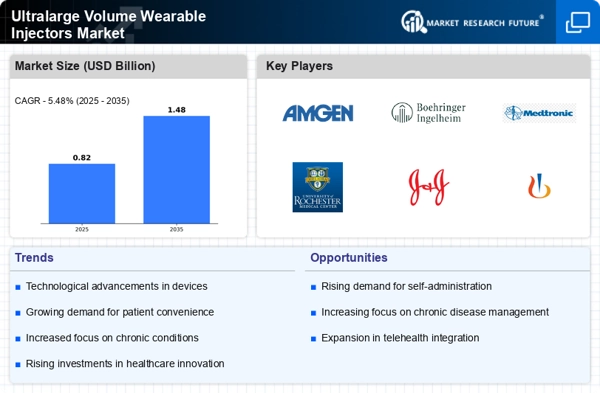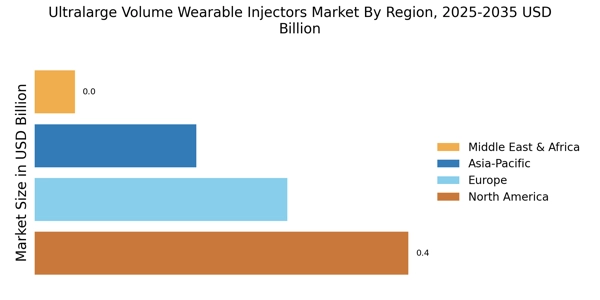Supportive Regulatory Environment
A supportive regulatory environment is fostering growth in the Ultralarge Volume Wearable Injectors Market. Regulatory bodies are increasingly recognizing the potential of wearable injectors to improve patient outcomes and are streamlining approval processes for innovative medical devices. This trend is evident in the expedited pathways for device approval, which encourage manufacturers to bring new products to market more quickly. Additionally, regulatory agencies are providing guidance on the development and testing of wearable injectors, ensuring that safety and efficacy standards are met. As a result, the market is likely to see an influx of new entrants and innovations, further driving competition and growth within the Ultralarge Volume Wearable Injectors Market.
Rising Prevalence of Chronic Diseases
The increasing incidence of chronic diseases such as diabetes, cardiovascular disorders, and autoimmune conditions is a primary driver for the Ultralarge Volume Wearable Injectors Market. As the global population ages, the demand for effective and convenient drug delivery systems rises. According to recent estimates, chronic diseases account for approximately 70% of all deaths worldwide, necessitating innovative treatment solutions. Wearable injectors offer a user-friendly alternative to traditional methods, allowing patients to self-administer medications with ease. This trend is likely to continue, as healthcare providers seek to improve patient outcomes and adherence to treatment regimens. Consequently, the Ultralarge Volume Wearable Injectors Market is poised for substantial growth, driven by the need for efficient management of chronic health conditions.
Increased Focus on Patient-Centric Care
The Ultralarge Volume Wearable Injectors Market is experiencing growth due to the heightened emphasis on patient-centric care models. Healthcare providers are increasingly recognizing the importance of tailoring treatment plans to individual patient needs, which includes the adoption of innovative drug delivery systems. Wearable injectors facilitate personalized medication regimens, allowing for adjustments based on patient feedback and health data. This approach not only enhances patient satisfaction but also improves treatment adherence and outcomes. As healthcare systems worldwide shift towards more personalized care, the demand for wearable injectors is expected to rise. This trend indicates a promising future for the Ultralarge Volume Wearable Injectors Market, as it aligns with the broader movement towards patient empowerment and engagement in their own healthcare.
Growing Demand for Home Healthcare Solutions
The shift towards home healthcare solutions is a significant factor propelling the Ultralarge Volume Wearable Injectors Market. Patients increasingly prefer receiving care in the comfort of their homes, which has led to a rise in demand for devices that facilitate self-administration of medications. Wearable injectors align with this trend by providing a convenient and efficient means for patients to manage their treatment regimens independently. The home healthcare market is projected to expand rapidly, with estimates suggesting a compound annual growth rate of over 8% in the coming years. This growth is likely to be accompanied by an increased adoption of wearable injectors, as they offer a practical solution for patients requiring frequent medication administration. Thus, the Ultralarge Volume Wearable Injectors Market stands to benefit from this evolving healthcare landscape.
Technological Innovations in Drug Delivery Systems
Technological advancements in drug delivery systems are significantly influencing the Ultralarge Volume Wearable Injectors Market. Innovations such as micro-needle technology, smart sensors, and automated dosing mechanisms enhance the functionality and reliability of wearable injectors. These advancements not only improve patient experience but also ensure precise medication delivery, which is crucial for chronic disease management. The market is witnessing a surge in research and development activities aimed at integrating digital health solutions with wearable injectors. For instance, the incorporation of mobile applications for monitoring and data collection is becoming increasingly common. This integration is expected to enhance patient engagement and adherence, thereby driving the growth of the Ultralarge Volume Wearable Injectors Market in the coming years.


















Leave a Comment